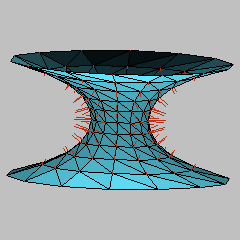

 |
This is the eigenvector field of an unstable discrete minimal catenoid which is associated to the single negative eigenvalue of the catenoid's discrete Jacobi operator.
As sufficiently large pieces of smooth minimal catenoids are unstable with respect to area and have index 1, i.e. the associated Jacobi operator has only one negative eigenvalue, we are not surprised to to find that the discrete minimal catenoid shown here has exactly one negative eigenvalue with respect to its discrete Jacobi operator. The eigenvector associated to the negative eigenvalue is given here as a variation vector field on the interior vertices of the surface. Moving the vertices in the direction of this field reduces area to second order.
We define discrete compact minimal surfaces as piecewise linear continuous compact triangulated surfaces that are critical for the area functional with respect to all variations through surfaces of the same type that preserve the simplicial structure and the boundary. See the model [5] referenced below for a more thorough definition. We remark that flipping any of the diagonals in the trapezoids that comprise the discrete catenoid shown here will not affect the minimality of the surface, as shown in [1].
Although discrete minimal surfaces are critical for area, they are not necessarily area minimizing. The discrete catenoid shown here is an unstable critical point of the discrete area functional. The authors have found an explicit representation of a four-parameter family of discrete catenoids whose set of vertices is dihedrally symmetric. These catenoids are the first explicitly known discrete minimal surfaces besides the trivial plane. We give the explicit representation in [1] and [4] referenced below.
Associated to the discrete area functional is a linear operator, the discrete Jacobi operator. As the surface is unstable, the first eigenvalue of that operator is negative. The corresponding first eigenvector field is shown here. (The discrete Jacobi operator is described in detail in the work [1] referenced below.)
The eigenvectors of the eigenfield on the surface shown here lie within planes through the central axis of the surface. However, in general there are eigenfields that do not have this property, and some of those are shown in [1]. The model was computed using JavaView [3].
Model produced with: JavaView version 2.00.a2
| Keywords | Minimal Surface; Discrete Surface; Catenoid; Surface of Revolution; Jacobi Operator | |
| MSC-2000 Classification | 53-04 (53-XX, 68Uxx, 68Rxx, 65Kxx, 65M50) | |
| Zentralblatt No. | 01683034 |
Submitted: Mon Jan 22 09:21:14 CET 2001.
Revised: Mon Aug 27 11:10:37 CET 2001.
Accepted: Tue Sep 11 15:19:17 CET 2001.
Technische Universität BerlinWayne Rossman
Fachbereich Mathematik
Straße des 17. Juni 136
10623 Berlin
Germany
polthier@math.tu-berlin.de
http://www-sfb288.math.tu-berlin.de/~konrad
Kobe University
Mathematics Department
Faculty of Science
Rokko, Kobe 657-8501
Japan
wayne@math.sci.kobe-u.ac.jp
http://www.math.kobe-u.ac.jp/HOME/wayne/wayne.html